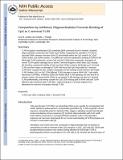| dc.contributor.author | Avalos, Ana M. | |
| dc.contributor.author | Ploegh, Hidde | |
| dc.date.accessioned | 2014-02-18T20:23:33Z | |
| dc.date.available | 2014-02-18T20:23:33Z | |
| dc.date.issued | 2011-10 | |
| dc.date.submitted | 2011-07 | |
| dc.identifier.issn | 00142980 | |
| dc.identifier.issn | 1521-4141 | |
| dc.identifier.uri | http://hdl.handle.net/1721.1/84991 | |
| dc.description.abstract | TLR9 recognizes unmethylated CpG-containing DNA commonly found in bacteria. Synthetic oligonucleotides containing CpG-motifs (CpG ODNs) recapitulate the activation of TLR9 by microbial DNA, whereas inversion of the CG dinucleotide within the CpG motif to GC (GpC ODNs) renders such ODNs inactive. This difference cannot be attributed to binding of ODNs to the full-length TLR9 ectodomain, as both CpG and GpC ODNs bind comparably. Activation of murine TLR9 requires cleavage into an active C-terminal fragment, which binds CpG robustly. We therefore compared the ability of CpG and GpC ODNs to bind to full-length and C-terminal TLR9, and their impact on the cleavage of TLR9. We found that CpG binds better to C-terminal TLR9 when compared with GpC, despite comparably low binding of both ODNs to full-length TLR9. Neither CpG nor GpC ODNs affected TLR9 cleavage in murine RAW 264.7 cells stably expressing TLR9-Myc. Inhibitory ODNs (IN-ODNs) block TLR9 signaling, but how they do so remains unclear. We show here that inhibitory ODNs do not impede TLR9 cleavage but bind to C-terminal TLR9 preferentially, and thereby compete for CpG ODN binding both in RAW cells and in TLR9-deficient cells transduced with TLR9-Myc. Ligand binding to C-terminal fragment thus determines the outcome of activation through TLR9. | en_US |
| dc.description.sponsorship | National Institutes of Health (U.S.) (Grant 5R01AI033456-21) | en_US |
| dc.language.iso | en_US | |
| dc.publisher | Wiley Blackwell | en_US |
| dc.relation.isversionof | http://dx.doi.org/10.1002/eji.201141563 | en_US |
| dc.rights | Creative Commons Attribution-Noncommercial-Share Alike | en_US |
| dc.rights.uri | http://creativecommons.org/licenses/by-nc-sa/4.0/ | en_US |
| dc.source | PMC | en_US |
| dc.title | Competition by inhibitory oligonucleotides prevents binding of CpG to C-terminal TLR9 | en_US |
| dc.type | Article | en_US |
| dc.identifier.citation | Avalos, Ana M., and Hidde L. Ploegh. “Competition by inhibitory oligonucleotides prevents binding of CpG to C-terminal TLR9.” European Journal of Immunology 41, no. 10 (October 6, 2011): 2820-2827. | en_US |
| dc.contributor.department | Massachusetts Institute of Technology. Department of Biology | en_US |
| dc.contributor.department | Whitehead Institute for Biomedical Research | en_US |
| dc.contributor.mitauthor | Ploegh, Hidde | en_US |
| dc.relation.journal | European Journal of Immunology | en_US |
| dc.eprint.version | Author's final manuscript | en_US |
| dc.type.uri | http://purl.org/eprint/type/JournalArticle | en_US |
| eprint.status | http://purl.org/eprint/status/PeerReviewed | en_US |
| dspace.orderedauthors | Avalos, Ana M.; Ploegh, Hidde L. | en_US |
| dc.identifier.orcid | https://orcid.org/0000-0002-1090-6071 | |
| mit.license | OPEN_ACCESS_POLICY | en_US |
| mit.metadata.status | Complete | |
